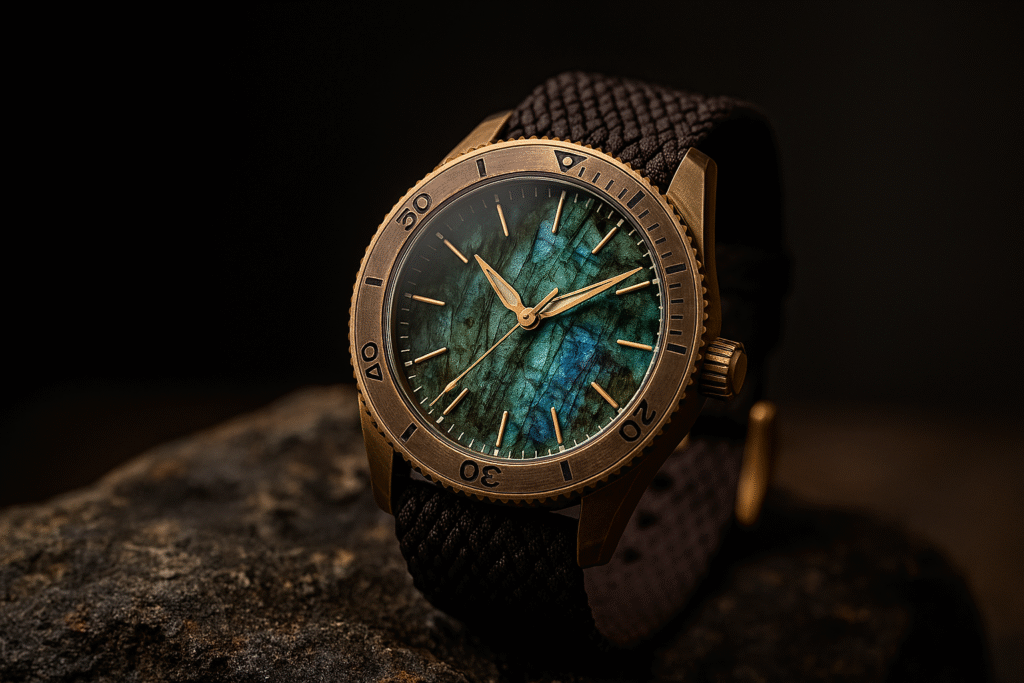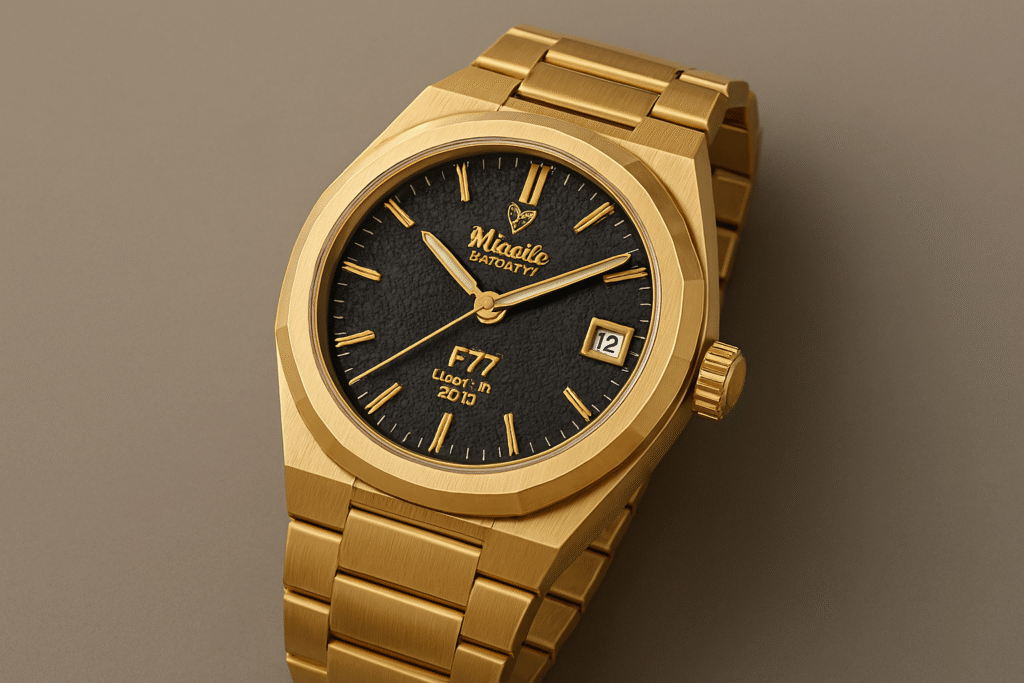Introduction
The Signum Cero Bronze Labradorite Watch is a unique collector’s timepiece. It combines a natural Labradorite dial, CuSn8 bronze case, Japanese automatic movement, and evolving patina. Each watch is one-of-a-kind, offering a dynamic piece that changes over time. Explore related watches in the gemstone watch guide.
Labradorite Dial in the Signum Cero Watch
The dial is crafted from Labradorite, a feldspar mineral first discovered in Labrador, Canada.
- Base colors: deep blue or purple
- Flashes of gold, yellow, or violet appear at certain angles
- Each dial is completely unique
Collectors who enjoy stone dials may also find the stone dial collector’s guide useful. The Labradorite’s natural optical effect ensures no two watches look alike.
Bronze Case and Patina Development
The CuSn8 bronze case comes in 39.5mm and 42.5mm. Bronze reacts naturally with air and moisture, forming a patina that gives each watch a personal character. Learn more in my bronze watch care guide.
Patina development depends on wear and climate, giving every timepiece a unique story. Collectors often prefer leaving the patina untouched for its aesthetic value.
NH35 and NH38 Japanese Movements
The Cero offers:
- NH35 automatic with lumed date disc
- NH38 automatic without date
These movements are widely trusted in microbrand watches (Seiko Instruments). For more details, see the NH35 vs NH38 guide or the automatic watch movement overview.
Why Collectors Choose the Signum Cero Bronze Labradorite Watch
- Unique stone dial patterns
- Patina evolves differently for every wearer
- Light reveals dynamic flashes of color
This combination of natural stone, bronze aging, and reliable movement makes the Signum Cero Bronze Labradorite Watch highly valued among collectors.
FAQ
Q: Will my dial match the photos?
A: Each dial is unique; flashes appear only at certain angles.
Q: How fast does patina form?
A: Usually within weeks, depending on humidity and air exposure.
Q: Can I polish the bronze case?
A: Yes, though most collectors prefer the natural patina.
Q: Why is the NH35 movement popular?
A: Known for precision and durability (Seiko Instruments).
Q: What case sizes are available?
A: 39.5mm or 42.5mm, with optional date or no-date.
Small Luxury Hotels FAQ
Introduction
This small luxury hotels FAQ answers common questions about boutique stays. It explains definitions, differences with large chains, and which services to expect. In addition, it covers family options, sustainability, and tips on finding the right property.
What defines a small luxury hotel?
- Fewer than 100 rooms.
- Personalized attention and privacy.
- Strong links to local design.
- Locations in unique urban or rural areas.
As a result, travelers often choose them for a more intimate experience. Moreover, their distinctive style sets them apart from standardized hotels.
Why choose a small luxury hotel?
Personal service
Staff remember guest details, therefore creating a sense of familiarity.
Calm spaces
Unlike large hotels, these properties feel quieter, so you can relax more easily.
Local culture
For example, menus highlight regional produce, and interiors reflect local crafts.
In addition, many guests return because the experience feels authentic.
How do small luxury hotels differ from large chains?
Guest experience
Small hotels provide tailored attention, while chains rely on uniform systems.
Property identity
Each boutique hotel has its own theme. On the other hand, large chains repeat formats worldwide.
Dining approach
Menus change seasonally and locally. Therefore, guests enjoy fresh variety instead of standard global menus.
Are small luxury hotels only for leisure stays?
Business features
- Lounges double as meeting rooms.
- Private dining options support work dinners.
Digital needs
- Fast Wi-Fi supports remote work.
- Quiet spaces help concentration.
Because of these advantages, small luxury hotels appeal to both business and leisure travelers.
What services can you expect?
- Concierge services for tours and dining.
- Fine dining menus with seasonal ingredients.
- Spa and wellness treatments.
- Added extras like minibars and welcome gifts.
Moreover, services shift depending on location. For example, a city hotel might offer cultural tours, while a rural retreat offers farm experiences.
Are small luxury hotels family-friendly?
Options for families
- Connecting rooms for parents and children.
- Child-friendly amenities such as menus or games.
Adults-only stays
- Some properties focus on privacy.
- Guests find peaceful, child-free environments.
Therefore, always check booking policies, because each hotel sets its own approach.
Do these hotels support sustainability?
Sourcing and dining
Farm-to-table meals reduce transport impact. In addition, guests enjoy fresher produce.
Environmental focus
Plastic use is restricted, while refillable bottles are encouraged. Smart energy systems reduce wastage.
Local involvement
Hotels support the community by hiring regionally. As a result, growth extends beyond the property.
How do you find the right small luxury hotel?
Define needs
Decide if food, spa, culture, or privacy is your top priority.
Check guest feedback
For example, repeat reviews about service often signal consistency.
Compare value
Packages may include meals, transfers, or early check-in. Therefore, higher prices can still deliver stronger value.
Are small luxury hotels worth the price?
Value of service
Guests pay for attention, comfort, and privacy. Moreover, experiences feel tailored and unique.
Extras add value
Some hotels include exclusive experiences or benefits. Finally, weigh these extras against nightly rates.
As a result, many travelers feel these hotels justify their price when quality matters most.


